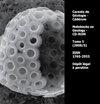只是换个地方吃草?意大利中新世海洋脊椎动物粪化石中棘类动物摄食痕迹的罕见发现及其古行为学意义
IF 1.5
4区 地球科学
Q2 GEOLOGY
引用次数: 2
摘要
海洋脊椎动物和大型无脊椎动物产生的粪便含有足够的有机物质,为各种大型动物提供了可用的食物来源。在一些现存的海洋环境中,食腐甚至代表了食物网中至关重要的营养相互作用。在古代生态系统中,宏观动物的食腐行为偶尔会在粪化石上出现咬痕或挖洞的例子。在这里,我们报道了在Pietra leccese(中新世,意大利南部)海洋钙质沉积物中保存完好的脊椎动物咬伤脊椎动物粪化石上的Gnathichnus pentax。这一不寻常的现象被解释为常规棘足类动物觅食活动的证据;特别是,它可能代表探索性食粪或浏览藻类(微生物)膜,在粪便的外部局部发展。加强前一种解释,淹没粪便上微生物群落的发展往往导致其破坏;此外,众所周知,一些现存的南极棘皮动物通常以脊椎动物的粪便为食,据信,食粪行为在海胆中相当普遍。反过来,支持藻类啃食假说的是,只有粪便外部表面的有限区域被啃食,由此产生的痕迹被清晰地定义,这表明,当粪便已经相当坚硬时,进食的海胆瞄准了粪便外部的一个精确位置。据我们所知,这里研究的五子龙标本代表了该鱼分类单元在粪化石上的首次公开记录。本文章由计算机程序翻译,如有差异,请以英文原文为准。
Just a different place to graze? An unusual occurrence of the echinoid feeding trace Gnathichnus pentax on a marine vertebrate coprolite (Miocene, Italy) and its palaeoethological implications
Faeces produced by marine vertebrates and macro-invertebrates contain sufficient organic matter to represent a usable food source for a wide array of macroscopic animals. In some extant marine environments, coprophagy even represents a crucial trophic interaction in food webs. In ancient ecosystems, coprophagy by macroscopic animals is occasionally exemplified by coprolites that exhibit biting traces or burrows. Here, we report Gnathichnus pentax on an exquisitely preserved vertebrate-bitten vertebrate coprolite from the marine calcareous deposits of the Pietra leccese (Miocene, southern Italy). This unusual occurrence is interpreted as evidence of the feeding activity of a regular echinoid; in particular, it may represent either exploratory coprophagy or the browsing of an algal (microbial) film that locally developed on the exterior of the faeces. Strengthening the former interpretation, the development of microbial communities on submerged faeces often leads to their destruction; furthermore, some extant Antarctic echinoderms are well known to ordinarily feed on vertebrate faeces, and coprophagy is believed to be fairly widespread among sea urchins. Supporting the algal browsing hypothesis, in turn, only a limited area of the external surface of the faeces was subject to grazing, and the resulting trace is neatly defined, which suggest that the feeding sea urchin targeted a precise location on the dung's exterior when the latter was already rather firm. To our knowledge, the G. pentax specimen studied here represents the first published record of this ichnotaxon on a coprolite.
求助全文
通过发布文献求助,成功后即可免费获取论文全文。
去求助
来源期刊

Carnets De Geologie
Earth and Planetary Sciences-Geology
CiteScore
2.90
自引率
14.30%
发文量
21
审稿时长
>12 weeks
期刊介绍:
Information not localized
 求助内容:
求助内容: 应助结果提醒方式:
应助结果提醒方式:


